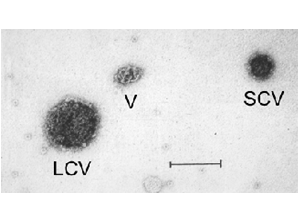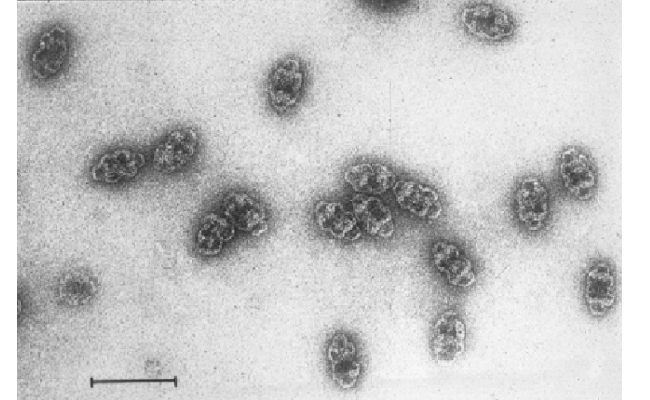Scientists: History

In the mid 1980s the Rome Laboratory at the UCLA School of Medicine was studying the biogenesis of lysosomal enzymes. These enzymes are shuttled intracellularly in coated vesicles. Drs. Nancy Kedersha and Leonard Rome were separating subpopulations of coated vesicles using agarose gel electrophoresis. Vesicle purity was monitored by examining the purified fractions under the electron microscope using negative staining. One population of coated vesicles was contaminated with an unusual ovoid particle that was highly regular in its form and dimensions. A micrograph from this fraction is shown here.
The figure shows a negative stained TEM image from a coated vesicle preparation. Present is a large coated vesicle (LCV), a small coated vesicle (SCV) and an unusual particle which possessed a complex fenistrated morphology (V). The bar represents 100 nmeters.
Kedersha modified the purification procedure and was able to separate the ovoid particles away from the coated vesicles (Kedersha and Rome, 1986a). The purified particles are shown below.
The figure above shows a negative stained TEM image of purified vaults. The bar (lower left) is 100 nmeters (Kedersha and Rome, 1986a).
The purified ovoids were examined by SDS-PAGE. The gel revealed that the particle consisted largely of a single protein with a molecular mass of ~100 kD. Since coated vesicles contain a similar sized protein, and since the fenestrated morphology of the particle resembled the clathrin coat, a relationship to coated vesicles seemed likely. However, an antibody raised against the particle failed to react with any coated vesicle proteins. Furthermore no underlying membrane could be detected, thus establishing that the particles were novel and unrelated to coated vesicles. The particles were named Vaults, a term selected to describe their morphology which consists of multiple arches reminiscent of those that form vaulted ceilings of cathedrals (Kedersha and Rome, 1986b).
